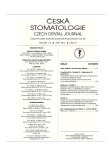Conservative Treatment of Temporomandibular Joint Disorders
Authors:
P. Hliňáková 1; T. Dostálová 1; L. Navrátil 2; V. Kroulíková 1; M. Bučková 1
Authors‘ workplace:
Dětská stomatologická klinika 2. LF UK a FN Motol, Praha
1; THERAP-THILIA, ambulantní oddělení v oboru fyzioterapie a komplexní léčebné rehabilitace, Praha
2
Published in:
Česká stomatologie / Praktické zubní lékařství, ročník 112, 2012, 5, s. 89-96
Category:
Original Article – Clinical Study
Overview
Introduction:
The etiology of temporomandibular joint disorders is multifactorial. The most frequent symptoms are pain and limited mouth opening. Nearly half of the population has difficulties with temporomandibular joint, patients suffer from common symptoms as for example pain, but only 15 per cent of these patients seek medical help. Accurate measurement, early diagnosis and classification of disorders of TMK as well as evaluation of available treatment methods, can significantly increase the effect of the therapy.
Methods:
The set of 115 patients was created during the study; all of them underwent initial preoperative examination consisting of history, clinical examination, radiographic examination and analysis of joint tracks and cephalometric analysis. Based on the results of the examinations, patients were divided into 7 groups according to the therapy used. The basic therapy was the conservative one. When the conservative treatment was unsuccessful a surgical therapy was used. The evaluation focused on these two criteria mainly the presence of pain before and after the therapy and the mouth opening before and after therapy.
Results:
The results we obtained showed that conservative therapy was successful in 94%. Only 6% of patients were indicated for surgical treatment.
Conclusion:
It is known that the TMD are caused by number of factors that could be summarized under the term civilization illness. Successful treatment is based on early diagnosis, correct classification and suitable treatment.
Key words:
dentistry – temporomandibular joint – classification of TMK disorders – pain – restricted mouth opening – conservative therapy
Sources
1. Cooper, B. C.: Examination of a large patient population for the presence of symptoms and signs of temporomandibular disorders. Cranio, roč. 25, 2007. č. 2, s.114–126.
2. Dostálová, T., Hliňáková, P., Kašparová, M., Řeháček, A., Vavřičková, L., Navrátil, L.: Photomedicine and laser surgery, 2012 – přijato v tisku.
3. Dostálová, T., Hliňáková, P., Hubáček, M., Michalík, P., Feltlová, E., Navrátil, L.: Poruchy temporomandibulárního kloubu. Klinické hodnocení pacientů s konzervativní terapií. Progresdent, roč. 15, 2009, č. 6, s. 14–20.
4. Goldstein, B.: Temporomandibular disorders: A review of current understanding. Oral Surg. Oral Med. Oral Pathol. Oral Radiol Endod., roč. 88, 1999, č. 4, s. 379–385.
5. Gray, R. J. M., Davies, S. J., Quayle, A. A.: A clinical approach to temporomandibular disorders: A clinical approach to treatment. Brit. Dent. J., roč. 177, 1994, č. 3, s. 101–106.
6. Hubáček, M., Hliňáková, P., Dostálová, T., Kozák, J., Denk, F.: Náhrady temporomandibulárního kloubu. Progresdent, roč. 16, 2010, č. 2, s. 28–34.
7. Christensen, L. V., Rassouli, M. N.: Experimental occlusal interferences. Part V. Mandibular rotations versus hemimandibular translations. J. Oral Rehabil., roč. 22, 1995, č. 12, s. 865–876.
8. Janega, M., Řeháček, A., Hofmanová, P., Dostálová, T., Šmahel, Z., Velemínská, J., Fendrychová, J.: Kefalometrická analýza telerentgenových snímků u zdravých dospělých pacientů z hlediska protetiky a ortodoncie. Čes. Stomat., roč. 109, 2009, č. 6, s. 112–116.
9. Machoň, V., a kol.: Léčba onemocnění čelistního kloubu. Praha, Grada, 2008. ISBN: 978-80-247-2394-5.
10. McNeill, C.: Temporomandibular disorders: Guidelines for classification, assessment and management, 2. vyd. Chicago, Quintessence Publishing Co., Inc. ISBN 13 : 9780867152531.
11. Navrátil, L., Hliňáková, P., Dostálová, T. , Blašková, E., Navrátil, V.: Zásady rehabilitační léčby při poruše temporomandibulárního kloubu. Progresdent, roč. 16, 2010, č. 1, s. 12–16.
12. Okeson, J. P.: Orofacial pain. Guidelines for assessment, diagnosis, and management. Chicago, Quintessence Publishing Co., Inc., 1996, s. 132–133. ISBN 13 : 9780867153125.
13. Slade, G. D.: Influence of psychological factors on risk of temporomandibular disorders. J. Dent. Res., 2007, č. 11, s. 1120–1125.
14. Zemen, J.: Konzervativní léčba temporomandibulárních poruch. Praha, Galén, 1999. ISBN 80-7262-005-3.
Labels
Maxillofacial surgery Orthodontics Dental medicineArticle was published in
Czech Dental Journal

2012 Issue 5
- What Effect Can Be Expected from Limosilactobacillus reuteri in Mucositis and Peri-Implantitis?
- The Importance of Limosilactobacillus reuteri in Administration to Diabetics with Gingivitis
Most read in this issue
- Papillary Cystadenoma Lymphomatosum (Warthin’s Tumour) of Parotic Salivary Glands with Multifocal Manifestation
- Tooth agenesis review
- Conservative Treatment of Temporomandibular Joint Disorders
- Cholesterol as an Aetiological Factor of Persistent Asymptomatic Apical Periodontitis
